Tax Law Case Study: Determining Australian Tax Residency Status
VerifiedAdded on 2023/06/07
|6
|1408
|243
Case Study
AI Summary
This case study addresses whether Tom, who worked in Brunei for two years, is considered an Australian resident for tax purposes under section 995-1 or subsection 6 (1) of the ITAA 1997. Applying the reside test, domicile test, and the 183-day test, the analysis concludes that Tom is a resident under the ordinary concepts and domicile test, but not the 183-day test. The receipts from his accounting service are treated as income under section 6-5 of the ITAA 1997. Desklib provides similar solved assignments and study resources for students.
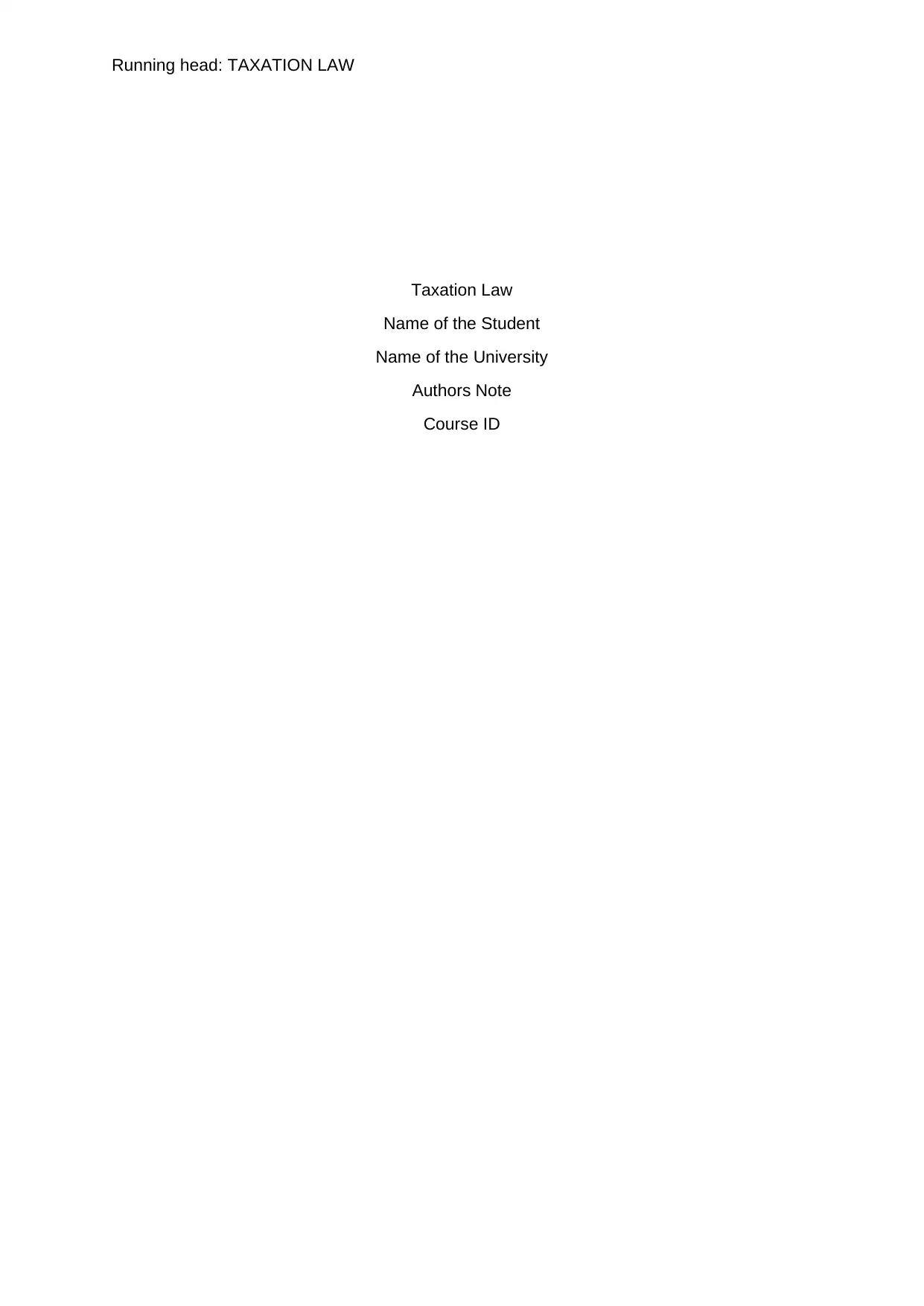
Running head: TAXATION LAW
Taxation Law
Name of the Student
Name of the University
Authors Note
Course ID
Taxation Law
Name of the Student
Name of the University
Authors Note
Course ID
Paraphrase This Document
Need a fresh take? Get an instant paraphrase of this document with our AI Paraphraser
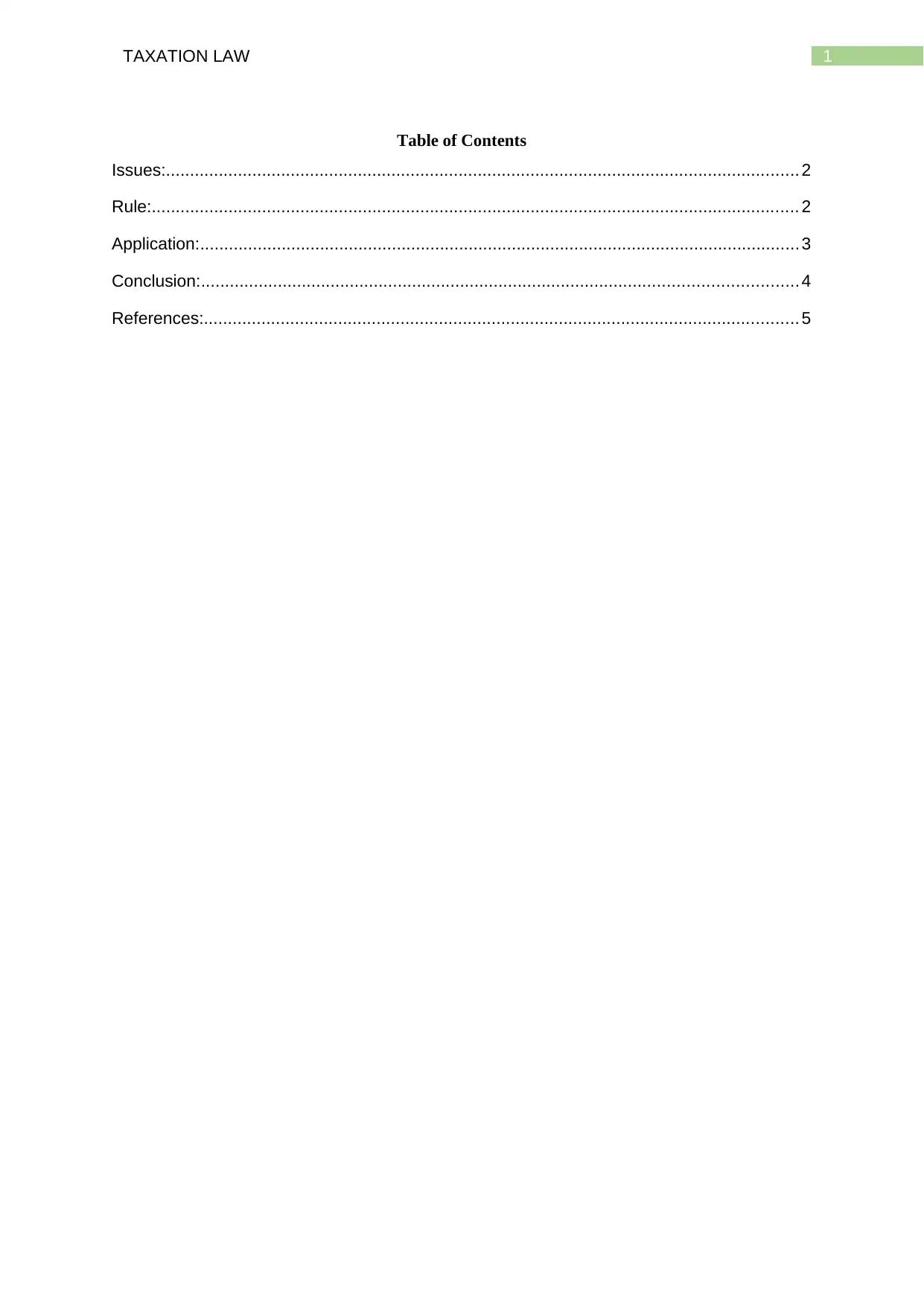
1TAXATION LAW
Table of Contents
Issues:.................................................................................................................................... 2
Rule:....................................................................................................................................... 2
Application:............................................................................................................................. 3
Conclusion:............................................................................................................................ 4
References:............................................................................................................................ 5
Table of Contents
Issues:.................................................................................................................................... 2
Rule:....................................................................................................................................... 2
Application:............................................................................................................................. 3
Conclusion:............................................................................................................................ 4
References:............................................................................................................................ 5
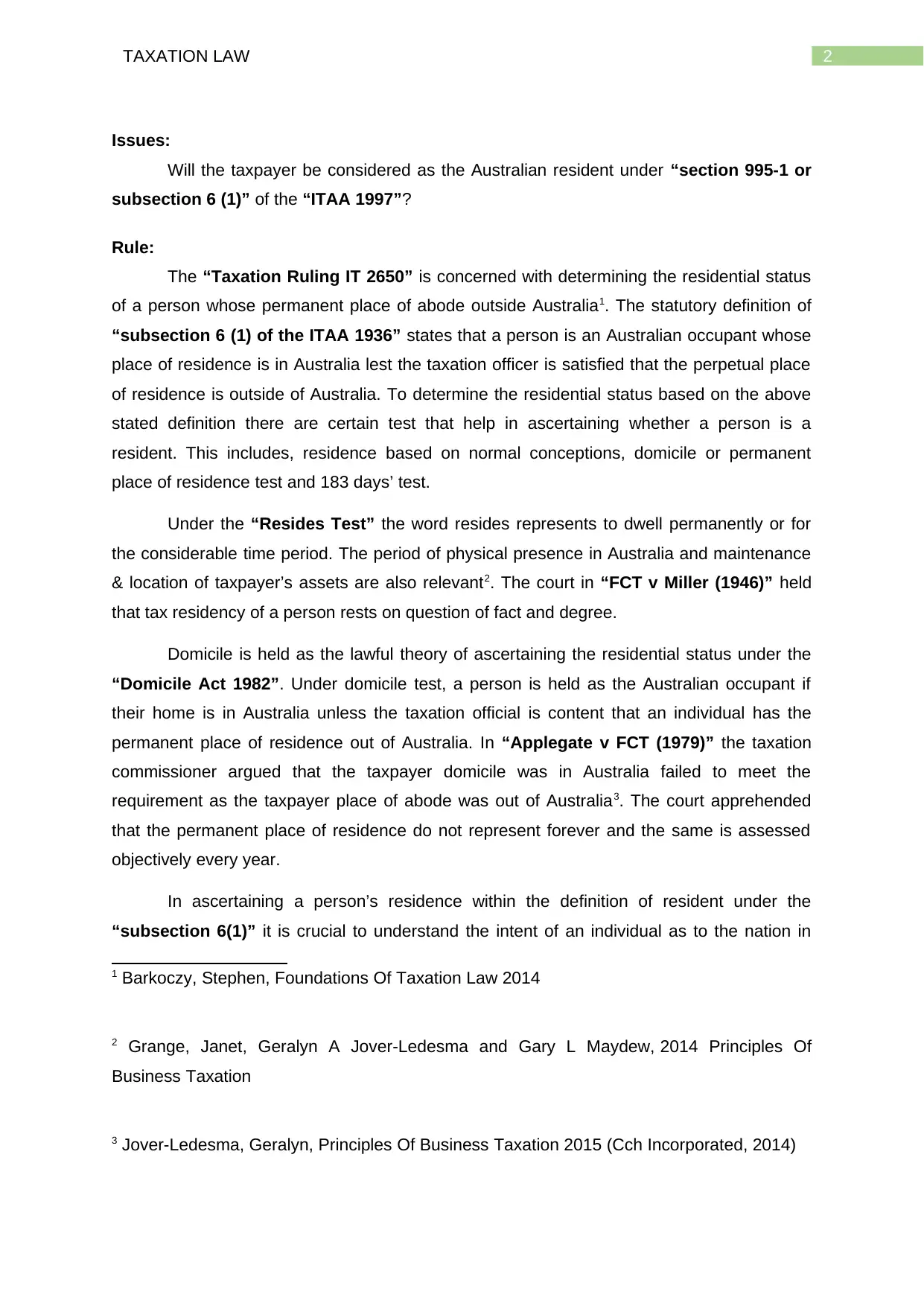
2TAXATION LAW
Issues:
Will the taxpayer be considered as the Australian resident under “section 995-1 or
subsection 6 (1)” of the “ITAA 1997”?
Rule:
The “Taxation Ruling IT 2650” is concerned with determining the residential status
of a person whose permanent place of abode outside Australia1. The statutory definition of
“subsection 6 (1) of the ITAA 1936” states that a person is an Australian occupant whose
place of residence is in Australia lest the taxation officer is satisfied that the perpetual place
of residence is outside of Australia. To determine the residential status based on the above
stated definition there are certain test that help in ascertaining whether a person is a
resident. This includes, residence based on normal conceptions, domicile or permanent
place of residence test and 183 days’ test.
Under the “Resides Test” the word resides represents to dwell permanently or for
the considerable time period. The period of physical presence in Australia and maintenance
& location of taxpayer’s assets are also relevant2. The court in “FCT v Miller (1946)” held
that tax residency of a person rests on question of fact and degree.
Domicile is held as the lawful theory of ascertaining the residential status under the
“Domicile Act 1982”. Under domicile test, a person is held as the Australian occupant if
their home is in Australia unless the taxation official is content that an individual has the
permanent place of residence out of Australia. In “Applegate v FCT (1979)” the taxation
commissioner argued that the taxpayer domicile was in Australia failed to meet the
requirement as the taxpayer place of abode was out of Australia3. The court apprehended
that the permanent place of residence do not represent forever and the same is assessed
objectively every year.
In ascertaining a person’s residence within the definition of resident under the
“subsection 6(1)” it is crucial to understand the intent of an individual as to the nation in
1 Barkoczy, Stephen, Foundations Of Taxation Law 2014
2 Grange, Janet, Geralyn A Jover-Ledesma and Gary L Maydew, 2014 Principles Of
Business Taxation
3 Jover-Ledesma, Geralyn, Principles Of Business Taxation 2015 (Cch Incorporated, 2014)
Issues:
Will the taxpayer be considered as the Australian resident under “section 995-1 or
subsection 6 (1)” of the “ITAA 1997”?
Rule:
The “Taxation Ruling IT 2650” is concerned with determining the residential status
of a person whose permanent place of abode outside Australia1. The statutory definition of
“subsection 6 (1) of the ITAA 1936” states that a person is an Australian occupant whose
place of residence is in Australia lest the taxation officer is satisfied that the perpetual place
of residence is outside of Australia. To determine the residential status based on the above
stated definition there are certain test that help in ascertaining whether a person is a
resident. This includes, residence based on normal conceptions, domicile or permanent
place of residence test and 183 days’ test.
Under the “Resides Test” the word resides represents to dwell permanently or for
the considerable time period. The period of physical presence in Australia and maintenance
& location of taxpayer’s assets are also relevant2. The court in “FCT v Miller (1946)” held
that tax residency of a person rests on question of fact and degree.
Domicile is held as the lawful theory of ascertaining the residential status under the
“Domicile Act 1982”. Under domicile test, a person is held as the Australian occupant if
their home is in Australia unless the taxation official is content that an individual has the
permanent place of residence out of Australia. In “Applegate v FCT (1979)” the taxation
commissioner argued that the taxpayer domicile was in Australia failed to meet the
requirement as the taxpayer place of abode was out of Australia3. The court apprehended
that the permanent place of residence do not represent forever and the same is assessed
objectively every year.
In ascertaining a person’s residence within the definition of resident under the
“subsection 6(1)” it is crucial to understand the intent of an individual as to the nation in
1 Barkoczy, Stephen, Foundations Of Taxation Law 2014
2 Grange, Janet, Geralyn A Jover-Ledesma and Gary L Maydew, 2014 Principles Of
Business Taxation
3 Jover-Ledesma, Geralyn, Principles Of Business Taxation 2015 (Cch Incorporated, 2014)
⊘ This is a preview!⊘
Do you want full access?
Subscribe today to unlock all pages.

Trusted by 1+ million students worldwide

3TAXATION LAW
which a person makes their home indefinitely4. Hence, a person with the Australian
residence but living outside Australia would maintain the abode if the individual proposes to
coming back to Australia with an evidently expected and practically anticipated contingency.
The “183-day test” states that a person will be held as the Australian resident for
taxation purpose when a person’s physically present in Australia for a period of no less than
six months during the income year5. However, the exceptions include if the taxation official is
content that the taxpayer’s normal place of abode is out of Australia and the person does not
propose to take up the residency in Australia.
A receipt obtained through employment and providing personal service might be
considered for taxation under “section 6-5 of the ITAA 1997” as the ordinary income. As
held in “CT v Scott (1935)” the term income should be considered based on the ordinary
concepts6. A nexus with the receipt arising out of taxpayer’s personal service is regarded as
ordinary income. This includes salary or wages, fees charged for rendering any service.
Application:
In the current case of Tom, he signed the agreement of acting as the plantation
manager in Brunei which stipulated him to stay in Brunei for two years with possible of
another year. Though Tom did not have any definite view of accepting or rejecting however
would consider an extension at the end of two-year period.
With reference to “Reside Test” Tom had maintained his physical maintenance of
place of abode in Australia as he did not abandon his Sydney residence and rented out the
same while his stay in Brunei. Furthermore, he also maintained his Australian bank account
where his rental income was paid. Tom has maintained his location and physical asset such
as Australian bank account. With reference to “Miller v FCT (1946)” Tom’s intention and
purpose of presence in Brunei was transitory as the taxpayer later rejected the offer of
accepting the extension of contract. Therefore, Tom will be considered resident under the
ordinary concept test.
4 Kenny, Paul, Australian Tax 2013 (LexisNexis Butterworths, 2013)
5 Krever, Richard E, Australian Taxation Law Cases 2013 (Thomson Reuters, 2013)
6 Morgan, Annette, Colleen Mortimer and Dale Pinto, A Practical Introduction To Australian
Taxation Law (CCH Australia, 2013)
which a person makes their home indefinitely4. Hence, a person with the Australian
residence but living outside Australia would maintain the abode if the individual proposes to
coming back to Australia with an evidently expected and practically anticipated contingency.
The “183-day test” states that a person will be held as the Australian resident for
taxation purpose when a person’s physically present in Australia for a period of no less than
six months during the income year5. However, the exceptions include if the taxation official is
content that the taxpayer’s normal place of abode is out of Australia and the person does not
propose to take up the residency in Australia.
A receipt obtained through employment and providing personal service might be
considered for taxation under “section 6-5 of the ITAA 1997” as the ordinary income. As
held in “CT v Scott (1935)” the term income should be considered based on the ordinary
concepts6. A nexus with the receipt arising out of taxpayer’s personal service is regarded as
ordinary income. This includes salary or wages, fees charged for rendering any service.
Application:
In the current case of Tom, he signed the agreement of acting as the plantation
manager in Brunei which stipulated him to stay in Brunei for two years with possible of
another year. Though Tom did not have any definite view of accepting or rejecting however
would consider an extension at the end of two-year period.
With reference to “Reside Test” Tom had maintained his physical maintenance of
place of abode in Australia as he did not abandon his Sydney residence and rented out the
same while his stay in Brunei. Furthermore, he also maintained his Australian bank account
where his rental income was paid. Tom has maintained his location and physical asset such
as Australian bank account. With reference to “Miller v FCT (1946)” Tom’s intention and
purpose of presence in Brunei was transitory as the taxpayer later rejected the offer of
accepting the extension of contract. Therefore, Tom will be considered resident under the
ordinary concept test.
4 Kenny, Paul, Australian Tax 2013 (LexisNexis Butterworths, 2013)
5 Krever, Richard E, Australian Taxation Law Cases 2013 (Thomson Reuters, 2013)
6 Morgan, Annette, Colleen Mortimer and Dale Pinto, A Practical Introduction To Australian
Taxation Law (CCH Australia, 2013)
Paraphrase This Document
Need a fresh take? Get an instant paraphrase of this document with our AI Paraphraser
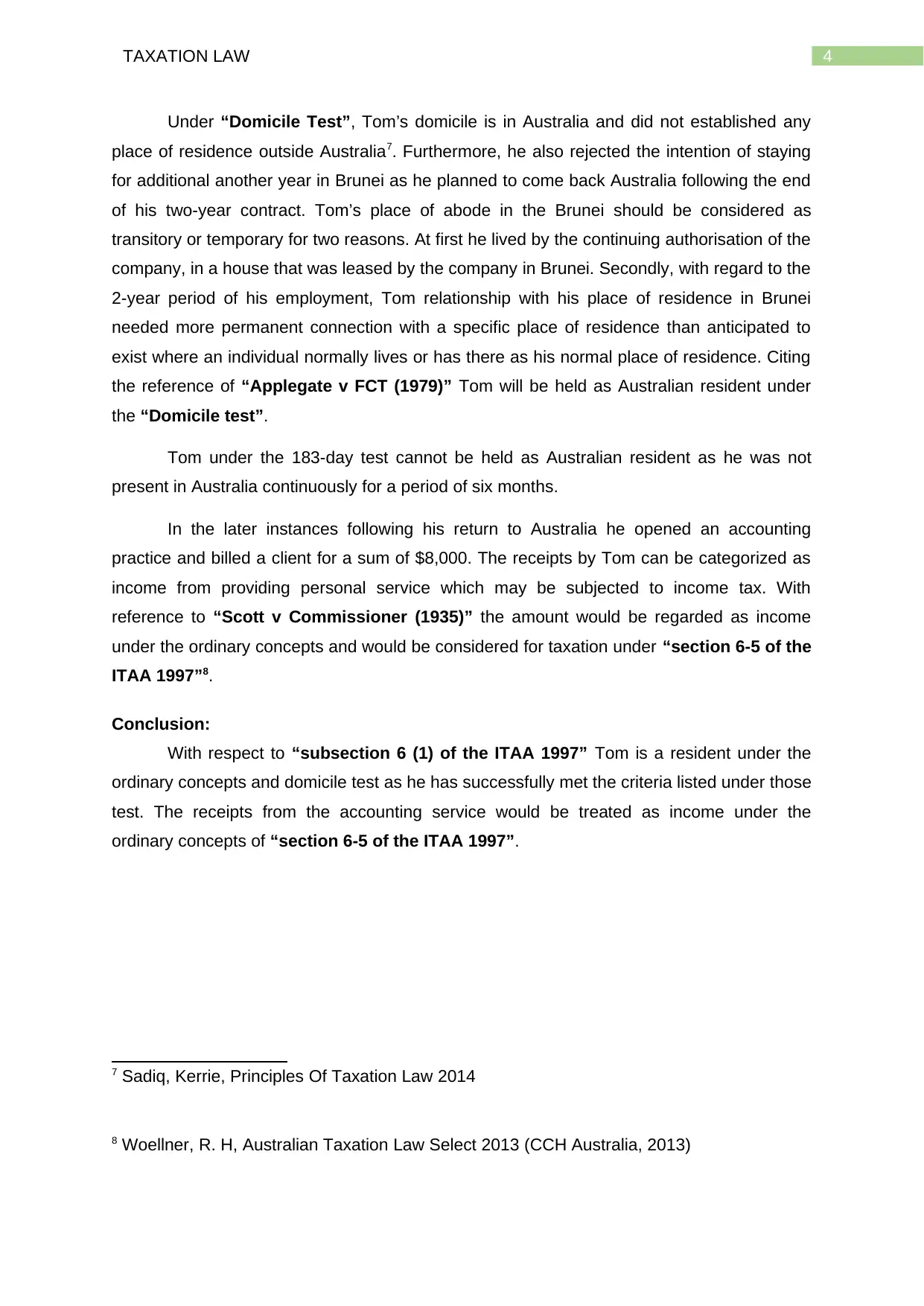
4TAXATION LAW
Under “Domicile Test”, Tom’s domicile is in Australia and did not established any
place of residence outside Australia7. Furthermore, he also rejected the intention of staying
for additional another year in Brunei as he planned to come back Australia following the end
of his two-year contract. Tom’s place of abode in the Brunei should be considered as
transitory or temporary for two reasons. At first he lived by the continuing authorisation of the
company, in a house that was leased by the company in Brunei. Secondly, with regard to the
2-year period of his employment, Tom relationship with his place of residence in Brunei
needed more permanent connection with a specific place of residence than anticipated to
exist where an individual normally lives or has there as his normal place of residence. Citing
the reference of “Applegate v FCT (1979)” Tom will be held as Australian resident under
the “Domicile test”.
Tom under the 183-day test cannot be held as Australian resident as he was not
present in Australia continuously for a period of six months.
In the later instances following his return to Australia he opened an accounting
practice and billed a client for a sum of $8,000. The receipts by Tom can be categorized as
income from providing personal service which may be subjected to income tax. With
reference to “Scott v Commissioner (1935)” the amount would be regarded as income
under the ordinary concepts and would be considered for taxation under “section 6-5 of the
ITAA 1997”8.
Conclusion:
With respect to “subsection 6 (1) of the ITAA 1997” Tom is a resident under the
ordinary concepts and domicile test as he has successfully met the criteria listed under those
test. The receipts from the accounting service would be treated as income under the
ordinary concepts of “section 6-5 of the ITAA 1997”.
7 Sadiq, Kerrie, Principles Of Taxation Law 2014
8 Woellner, R. H, Australian Taxation Law Select 2013 (CCH Australia, 2013)
Under “Domicile Test”, Tom’s domicile is in Australia and did not established any
place of residence outside Australia7. Furthermore, he also rejected the intention of staying
for additional another year in Brunei as he planned to come back Australia following the end
of his two-year contract. Tom’s place of abode in the Brunei should be considered as
transitory or temporary for two reasons. At first he lived by the continuing authorisation of the
company, in a house that was leased by the company in Brunei. Secondly, with regard to the
2-year period of his employment, Tom relationship with his place of residence in Brunei
needed more permanent connection with a specific place of residence than anticipated to
exist where an individual normally lives or has there as his normal place of residence. Citing
the reference of “Applegate v FCT (1979)” Tom will be held as Australian resident under
the “Domicile test”.
Tom under the 183-day test cannot be held as Australian resident as he was not
present in Australia continuously for a period of six months.
In the later instances following his return to Australia he opened an accounting
practice and billed a client for a sum of $8,000. The receipts by Tom can be categorized as
income from providing personal service which may be subjected to income tax. With
reference to “Scott v Commissioner (1935)” the amount would be regarded as income
under the ordinary concepts and would be considered for taxation under “section 6-5 of the
ITAA 1997”8.
Conclusion:
With respect to “subsection 6 (1) of the ITAA 1997” Tom is a resident under the
ordinary concepts and domicile test as he has successfully met the criteria listed under those
test. The receipts from the accounting service would be treated as income under the
ordinary concepts of “section 6-5 of the ITAA 1997”.
7 Sadiq, Kerrie, Principles Of Taxation Law 2014
8 Woellner, R. H, Australian Taxation Law Select 2013 (CCH Australia, 2013)
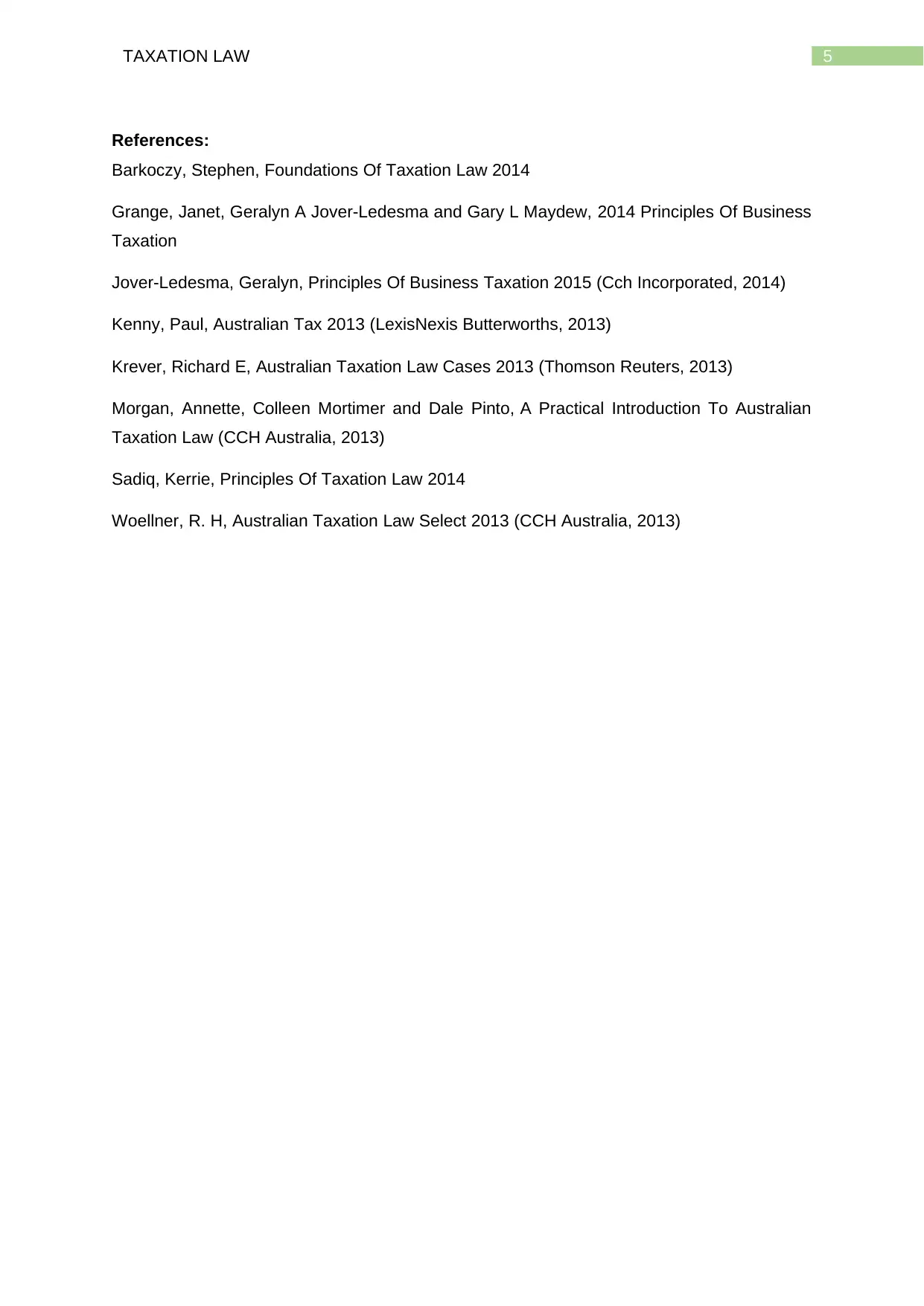
5TAXATION LAW
References:
Barkoczy, Stephen, Foundations Of Taxation Law 2014
Grange, Janet, Geralyn A Jover-Ledesma and Gary L Maydew, 2014 Principles Of Business
Taxation
Jover-Ledesma, Geralyn, Principles Of Business Taxation 2015 (Cch Incorporated, 2014)
Kenny, Paul, Australian Tax 2013 (LexisNexis Butterworths, 2013)
Krever, Richard E, Australian Taxation Law Cases 2013 (Thomson Reuters, 2013)
Morgan, Annette, Colleen Mortimer and Dale Pinto, A Practical Introduction To Australian
Taxation Law (CCH Australia, 2013)
Sadiq, Kerrie, Principles Of Taxation Law 2014
Woellner, R. H, Australian Taxation Law Select 2013 (CCH Australia, 2013)
References:
Barkoczy, Stephen, Foundations Of Taxation Law 2014
Grange, Janet, Geralyn A Jover-Ledesma and Gary L Maydew, 2014 Principles Of Business
Taxation
Jover-Ledesma, Geralyn, Principles Of Business Taxation 2015 (Cch Incorporated, 2014)
Kenny, Paul, Australian Tax 2013 (LexisNexis Butterworths, 2013)
Krever, Richard E, Australian Taxation Law Cases 2013 (Thomson Reuters, 2013)
Morgan, Annette, Colleen Mortimer and Dale Pinto, A Practical Introduction To Australian
Taxation Law (CCH Australia, 2013)
Sadiq, Kerrie, Principles Of Taxation Law 2014
Woellner, R. H, Australian Taxation Law Select 2013 (CCH Australia, 2013)
⊘ This is a preview!⊘
Do you want full access?
Subscribe today to unlock all pages.

Trusted by 1+ million students worldwide
1 out of 6
Related Documents
Your All-in-One AI-Powered Toolkit for Academic Success.
+13062052269
info@desklib.com
Available 24*7 on WhatsApp / Email
![[object Object]](/_next/static/media/star-bottom.7253800d.svg)
Unlock your academic potential
Copyright © 2020–2026 A2Z Services. All Rights Reserved. Developed and managed by ZUCOL.





